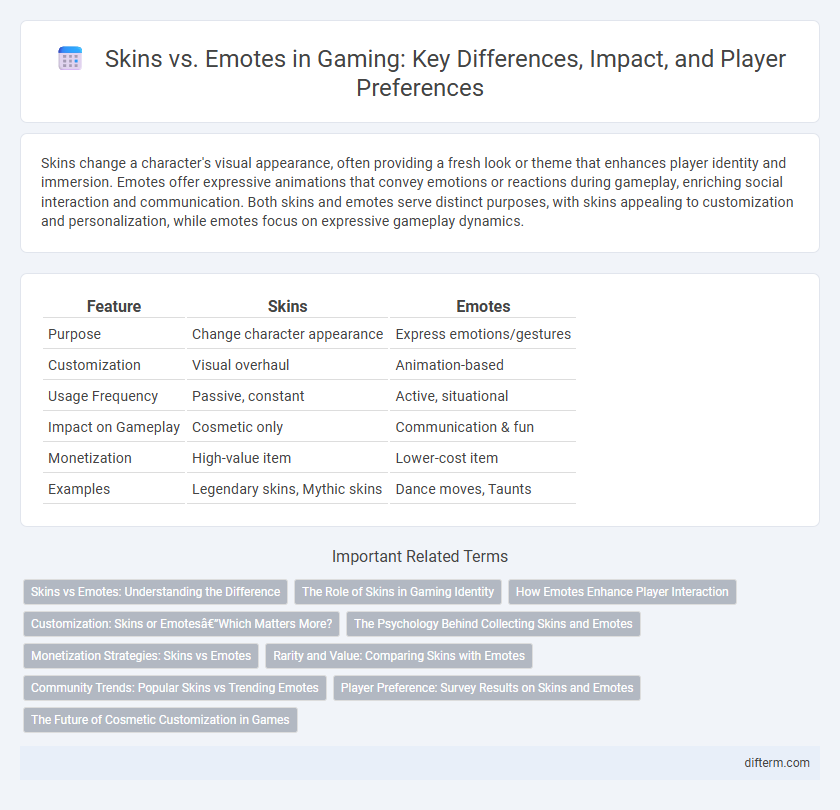Skins change a character's visual appearance, often providing a fresh look or theme that enhances player identity and immersion. Emotes offer expressive animations that convey emotions or reactions during gameplay, enriching social interaction and communication. Both skins and emotes serve distinct purposes, with skins appealing to customization and personalization, while emotes focus on expressive gameplay dynamics.
Table of Comparison
| Feature | Skins | Emotes |
|---|---|---|
| Purpose | Change character appearance | Express emotions/gestures |
| Customization | Visual overhaul | Animation-based |
| Usage Frequency | Passive, constant | Active, situational |
| Impact on Gameplay | Cosmetic only | Communication & fun |
| Monetization | High-value item | Lower-cost item |
| Examples | Legendary skins, Mythic skins | Dance moves, Taunts |
Skins vs Emotes: Understanding the Difference
Skins alter a character's visual appearance, providing unique outfits, textures, and themes that enhance personalization and player identity. Emotes are expressive animations or gestures that convey emotions or actions during gameplay, adding interactive communication without changing the character's look. Understanding the difference between skins and emotes helps players optimize their customization experience in games like Fortnite, Apex Legends, and League of Legends.
The Role of Skins in Gaming Identity
Skins play a pivotal role in gaming identity by allowing players to customize their avatars, reflecting personal style and status within the community. Unlike emotes, which emphasize short-term expression, skins offer long-lasting visual differentiation that contributes to player recognition and social prestige. The ability to collect rare or exclusive skins often signifies commitment and expertise, enhancing a player's influence and presence in the gaming ecosystem.
How Emotes Enhance Player Interaction
Emotes enhance player interaction by providing a dynamic and expressive way for gamers to communicate beyond voice or text, fostering a deeper sense of camaraderie and teamwork. Unlike skins, which primarily affect visual aesthetics, emotes serve as tools for players to convey emotions, celebrate victories, or taunt opponents in real-time gameplay. This interactive layer enriches multiplayer experiences and strengthens social bonds within gaming communities.
Customization: Skins or Emotes—Which Matters More?
Skins offer players extensive visual customization by altering character appearance, armor, and weapon designs, which significantly impacts player identity and in-game presence. Emotes provide expressive customization, allowing players to convey emotions and interact socially without changing gameplay visuals. Prioritizing skins enhances personalization and status display, while emotes enrich communication and social engagement in gaming communities.
The Psychology Behind Collecting Skins and Emotes
Collecting skins and emotes taps into gamers' intrinsic desire for self-expression and social status within virtual communities. Skins often symbolize identity personalization, enhancing players' emotional attachment to their avatars, while emotes offer dynamic, non-verbal communication that fosters social interaction and camaraderie. This psychological engagement drives motivation to acquire rare or limited-edition items, reinforcing a sense of achievement and belonging.
Monetization Strategies: Skins vs Emotes
Monetization strategies in gaming heavily favor skins over emotes due to their higher perceived value and customization appeal, leading to increased player spending. Skins often generate significant revenue through limited-time exclusivity and tiered pricing, while emotes serve as lower-cost, frequent microtransactions that enhance player engagement. Game developers balance these assets to optimize profits, leveraging skins as premium offerings and emotes as accessible content to cater to diverse player preferences.
Rarity and Value: Comparing Skins with Emotes
Skins often hold higher rarity and value in gaming due to their visual impact and customization potential, frequently representing limited-time events or exclusive achievements. Emotes, while popular for personal expression and communication, usually have lower rarity and are more commonly accessible in-game or through basic purchase options. The market demand and collector interest typically drive the premium pricing of skins compared to emotes.
Community Trends: Popular Skins vs Trending Emotes
Popular skins often reflect iconic characters and limited-edition releases, driving community engagement through rarity and visual impact. Trending emotes reveal player expression and social interaction preferences, frequently gaining momentum via viral memes and esports events. Both skins and emotes contribute significantly to in-game identity, yet skins dominate in perceived value while emotes lead in dynamic player communication.
Player Preference: Survey Results on Skins and Emotes
Survey results indicate that 65% of players prefer skins over emotes for personalizing their in-game characters, valuing visual customization more than expressive gestures. Emotes remain popular among 35% of gamers who prioritize communication and social interaction during gameplay. These preferences vary by game genre, with battle royale players favoring skins and MOBA enthusiasts showing higher interest in emotes.
The Future of Cosmetic Customization in Games
Skins and emotes represent the core of cosmetic customization, with skins offering visual alterations to characters and emotes providing dynamic expressions and interactions. The future of cosmetic customization in games is moving toward highly personalized and AI-driven options, enabling players to craft unique identities that reflect their play style and personality. Advancements in procedural generation and blockchain technology promise to enhance ownership and rarity, transforming cosmetic items from simple aesthetics into valuable digital assets.
skins vs emotes Infographic

 difterm.com
difterm.com